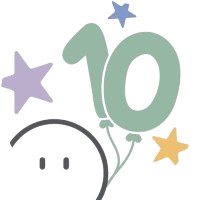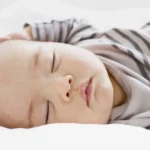Is Your Baby Overheating? Signs Your Baby Is Too Hot
You never want your little one to be overheated! If your baby is too hot, they’re probably uncomfortable, their sleep will be affected, and they can get heat rash. But there’s an important reason to be worried: Overheating babies increase the risk of infant sleep death, or SIDS.
Studies have shown that too much clothing, too many layers, and warm room temperatures are a risk factor for SIDS. The baby has a higher risk of SIDS in the winter season, which is a paradox. The reason is that parents worry that their baby might get cold and avoid it by overclothing them or setting the temperature very high.
Why Babies Overheat So Easily
Babies are not very efficient at regulating their core temperature. First of all, your body temperature rises a whole lot quicker than theirs. And secondly, babies and children sweat very much less, which reduces drastically on their ability to cool. And it’s not just that babies are more apt to become overheated, they’re more apt to die from a heat-related illness, too. For instance, because the sweat glands in babies are not yet developed, babies are at greater risk for developing heat rash or prickly heat.
At what age do babies begin to control their body temperature?
Because overheating is a proven SIDS risk factor, it’s especially important to make sure your sleeping baby is not overheated when he is under 1 year—and especially when he is under 6 months, when SIDS risk is greatest.
Normal Infant Temperature
A normal baby temperature is approximately 97.5 degrees Fahrenheit (36.4 degrees Celsius). Overheating baby and fever are around 100.4 degrees Fahrenheit (38 degrees Celsius) and above. Know that normal baby body temperatures will vary throughout the day.
Signs of a Baby Overheating
Luckily, it’s easy to know if your baby is overheating. Check the ears and neck. If their ears are hot and red—and their neck is sweaty—your baby is overheating. Dress them less warmly or lower the room temperature.
Is my baby overheating? How to tell.
Some signs of baby overheating are mentioned below:
Warm to touch
Red complexion
Increased heart rate
Fever but no sweating
Drowsy or unresponsive
Vomiting
Dizzy or disoriented
Will a baby wake up if it’s too hot?
While cold babies will resist sleep, being too hot won’t wake up your sleeping bub. That’s because sometimes being too hot can cause your babe to be lethargic. That’s why you need to monitor your babe for signs that they are too hot.
How do I know if my baby is too hot while sleeping?
Gently touch your baby’s ears or neck. If it is warm, then your baby is likely overheated. Also, flushed and sweating are definite indicators that your baby is overheated when sleeping.
Optimum Baby Room Temperature
No matter the season, keep the area where your infant is kept between 68 to 72 degrees Fahrenheit (20 to 22.2 degrees Celsius). You can measure your room temperature with a thermometer, but generally, the room will not be too hot or cold for an adult.
How to Prevent Overheating During Sleep
In addition to maintaining the thermostat at the ideal sleeping temperature, don’t over-bundle your baby for naps or nighttime with extra clothing or headgear. Here are some guidelines to avoid overheating your baby during sleep:
DON’T put a hat on your baby while sleeping. Hats are especially bad because covering their head keeps your baby from using their head as a little heater, losing excess heat. Also, in the middle of the night, a hat might fall over your little one’s face and cause them to struggle to breathe.
DO swaddle Baby in a cloth that breathes. In warm weather, your baby should be dressed in a short-sleeve bodysuit and a light, airy swaddle with a TOG rating of less than or equal to 1.0 TOG, or thermal overall grade. Sleepea 5-Second Swaddle, SNOO Sack, and Happiest Baby’s 100% organic cotton muslin swaddle blanket are good options. In cool weather, dress your baby in a long-sleeve cotton bodysuit or cotton footie PJs and a cotton swaddle. For colder naps, place your baby in a lightly insulating swaddle with a TOG rating of 2.0 to 3.5, like the breathable cotton Sleepea Comforter Swaddle or SNOO Comforter Sack. (Not synthetic fabrics like fleece, which can overheat babies.) For a rolling baby, substitute the swaddle with a lightweight sleep sack.
DON’T use loose blankets. Never put loose blankets in the crib, because they’re an overheating risk and a suffocation risk. (A safe crib is a toy-, blanket-, object-free crib except for a pacifier.)
DON’T use electric blankets (or heating pads) with your baby. They heat babies up too much and expose them to electromagnetic radiation.
DO place Baby’s bassinet away from the heater. Keep your baby out of arm’s reach from heating vents, radiators, portable heaters, and fireplaces to avoid overheating.
How to Prevent Overheating in the Winter
Bundling babies up for winter playtime—and cranking on the indoor heat—can easily lead them to overheat. Not only are babies terrible at regulating their body temperature, they lack adequate body fat to keep themselves insulated and warm. To make matters worse, newborns have yet to develop the shiver reflex, which contributes to generating body heat in the cold. Some useful precautions to avoid overheating your baby in the winter follow:
DO dress Baby in layers. Dress your little one in one more layer than you’re wearing. If your bub gets too warm, simply peel off a layer. For outdoors, start with a long-sleeve cotton bodysuit, then add soft pants, socks, and a sweater. If you’ve got a jacket on, your baby should have a jacket or snowsuit on, too—plus a blanket. Finally, don’t forget a hat, mittens, and warm booties to heat their head, hands, and feet
DON’T dress your baby in a sweater when using a baby carrier. If you’re wearing a baby carrier, your baby likely doesn’t need a sweater or sweatshirt under their jacket. That’s because your body heat will provide just enough extra warmth to keep your little one toasty, without overheating. (Make sure your little one’s face isn’t pressed against your chest or clothing!)
DO wear a blanket instead of a coat in the car. Bulky coats and snowsuits are not to be used in the car seat. They take up too much space under the harness, endangering your baby in the event of a car accident. Instead, strap your little one into their car seat coatless, then wrap the lower half of their body in a blanket. When the car warms up, remove the blanket.
How to Keep from Overheating During The Summer
It’s no wonder that warm outside temperatures put babies and kids at increased risk for overheating. These are some easy-to-do’s to keep your little one from overheating this summer:
DON’T go out when it is hottest. The sun’s rays are hottest at all times between about 10am and 2pm. Get outside for as little time as necessary when the sun shines hardest then. And sit in the shade otherwise!
DO get air conditioning. If you do not have a home air conditioner and you’re in a severe heat, seek out an AC building nearby, like the library or mall. And if you do have an AC, never let your baby sleep near the unit or they will be too cold.
DON’T cover the stroller. Covering your baby’s stroller with a muslin blanket may keep your bub safe from the sun, but it gets hot, so the stroller…and your baby get hotter. Instead, use a large canopy or mesh sun shield that is designed for strollers that provide shade and good ventilation.
DO hydrate. Babies get all the water they need from just breastmilk or formula, so on really hot days feed more of it. But never give your infant water in the first 6 months of life. Between the ages of 6 and 12 months, however, 4 to 8 ounces per day is acceptable. Get tips on how to keep Baby cool in a heat wave!
How to Cool Down an Overheated Baby
If you think your baby is over the top temperature-wise, then below are some instructions to follow to cool your baby down:
Give your baby fluids. If under 6 months, give breastmilk or formula exclusively. If 6 months to 1 year, give 4 to 8 ounces of water per day. (More details on how to introduce water into your baby!)
Take your baby to a cooler place. Keep in mind that lower levels—and shaded rooms—will be cooler.
Dress your baby in light clothing. Cotton and loose-fitting loose-fitting breathable fabric is ideal.
Sponge bath your baby with lukewarm/cooler water. Don’t use cold water and ice in the bath.
Use a cold compress. Put it on your baby’s forehead or on their limbs to cool them down.
If the signs of overheating are not getting better, call your pediatrician.
Baby Overheating & Heat Rash
Babies develop heat rash (prickly heat) when their salty sweat gets trapped and irritates the skin. It usually happens on your baby’s neck, armpits, chest, back, elbows, or thighs. The rash is a tiny red spots (irritated hair follicles) and patchy complexion and can be accompanied by fever, chills, and bumps. Heat rash will naturally clear up by itself within two to three days in most situations. But if you think your baby actually has a heat rash, call your doctor anyway. They can recommend sprinkling on a dusting of cornstarch powder—never talcum—to draw out sweat and calm irritation. A cold compress on the heat rash and cool baths for your bub can be beneficial, too.
Newborn Overheating vs. Fever
It’s normal to wonder if your warm baby has a fever. Check your baby’s temperature and talk to your doctor if you are unsure. (To take the most accurate temperature in babies and toddlers under the age of 3, use a rectal thermometer.) Other signs that indicate your baby could have a fever include:
Difficulty sleeping
Loss of appetite
No desire for playtime
Lethargic or not as active as usual
Any baby under 3 months who has a rectal temperature of 100.4 degrees F or higher, must be brought in to see a doctor. And any child over 104 degrees F fever must be evaluated. So if you see those numbers, don’t hesitate to call your pediatrician! (Read all about how to take your baby’s temperature—and what kind of thermometer to use.)
Baby Overheating: Final Thoughts
The most important thing to keep in mind is that babies lack good body temperature control, so you never want to leave them in the extreme temperatures, either cold or hot. If you ever question whether or not your baby is too hot, do the “ear check” just in case!



